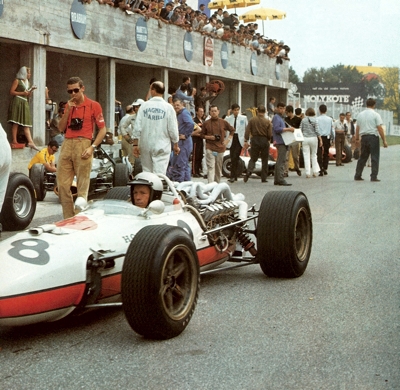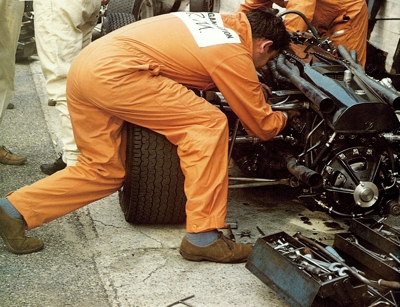 The screaming 3 liter Honda RA273 made its debut at the 1966 Italian GP. Its engine was a 60 degree V12 four cam with 4 valves per cylinder. Drive was taken from the center of the crankshaft to negate whip, and the (heavy) engine developed 430 bhp at a whopping 11,000 rpm. Richie Ginther was lucky to escape unhurt when the car crashed at high speed during the race. Its best showing was at Mexico City when Ginther finished fourth and set the fastest lap.
The screaming 3 liter Honda RA273 made its debut at the 1966 Italian GP. Its engine was a 60 degree V12 four cam with 4 valves per cylinder. Drive was taken from the center of the crankshaft to negate whip, and the (heavy) engine developed 430 bhp at a whopping 11,000 rpm. Richie Ginther was lucky to escape unhurt when the car crashed at high speed during the race. Its best showing was at Mexico City when Ginther finished fourth and set the fastest lap.
 Jackie Stewart's BRM P83 in the pits at Monza in 1966. The BRM 3 liter H16 engine was based on the cylinder blocks of the old 1.5 liter engine, and its only success was when it was fitted to Jim Clark's Lotus 43 for the 1966 US GP.
Jackie Stewart's BRM P83 in the pits at Monza in 1966. The BRM 3 liter H16 engine was based on the cylinder blocks of the old 1.5 liter engine, and its only success was when it was fitted to Jim Clark's Lotus 43 for the 1966 US GP. |
The Return of Power
The 1966 rule changes were heralded as 'The return of power'. Engine capacity was doubled to a maximum of 3 liters, while a category for supercharged engines (of 1
½-liters) made a return. The minimum weight limit was raised by only 50kg - to the 500kg limit which was originally envisaged for the 1
½-liter formula - and the requirements for use of pump petrol and open wheels remained. Although the new formula had been announced in 1963, the withdrawal of Coventry Climax had left most of the 'kit car' teams in a sorry predicament, and once again they were faced with a situation of compromise.
Ferrari were more ready than most. Their new car was based on a scaled up 1
½-liter-type chassis, carrying a V12 of a full 3 liters. The engine used two valves per cylinder and fuel injection in the centre of the Vee. The chassis was a semi-monocoque, with stressed panelling on a tubular structure. The 312 initially looked as though it might follow the path of the 156 of five years earlier, but reliability proved not to be its strong suit.
Full 3-lirre cars were few and far between in the first season but the ones that were around were technically interesting. Following in the path of fellow Antipodean Brabham as a constructor, Bruce McLaren entered the arena with a very interesting machine. The chassis of the first McLaren was usual in that it was of monocoque configuration, but rather than the traditional riveted and bonded aluminum panelling, this car employed an aviation-type material called Mallite. This consisted of two much thinner aluminum skins sandwiching a core of balsa wood, with the grains running from face to face, the whole being bonded together into an enormously light and stiff sheet.
The very advanced chassis which was thus built up was unfortunately let down by the lack of power from the de-stroked Indianapolis Ford engine which propelled it. While losing 1.2 liters from its original 4.2, the engine unfortunately lost much of its specific output and very little of its excess weight. The season was to belong to the man in whose footsteps McLaren was following, Jack Brabham himself. In slightly opportunist vein, Brabham and Tauranac penned the BT20, a simple space-frame chassis with even simpler outboard springing all round and of the smallest dimensions possible. Into this they fitted their master stroke, a cheap, light and unusually simple V8 engine built by the Australian Repco organisation around the bones of a mass-production Oldsmobile V8.
The Olds V8 had all the right basic ingredients, with a very short stroke and single-plane crankshaft; the addition of single-overhead-camshaft cylinder heads, with two valves per cylinder, netted an initial 285 bhp at 8000 rpm. That in itself was far from spectacular, but in such a mild state of tune the engine had a wide spread of usable power, lots of torque and a miserly thirst for fuel. Capitalising on this simplicity the two Australians made the car by far the lightest on the grids and one of the most reliable. The car took the Championship with consummate ease.
Of the others, Lotus initially relied on yet another development of the 33, whose superior handling could not compensate for the paucity of power of its 2-liter Climax or BRM engines. BRM themselves started the season with 2.1-liter versions of the P261, using a 2070 cc, 270 bhp engine, developed for the Tasman series. It was enough to give Stewart victory in the opening race, but thereafter every race was won by a 3-liter car. BRM's own 3-liter was another 16-cylinder concoction, with a reputation akin to that of their first example.
Aero-engine thinking had been cribbed to make a 16-cylinder unit short enough for rear mounting; two flat-eight units were mounted one atop the other, with their two crankshafts coupled to a common output. Use of major components from the successful V8 should have ensured both power and reliability but, owing to severe vibration problems, neither was forth-coming. The most power ever seen from the unit was 420 bhp - far short of target - and its most memorable characteristic was sudden and violent self destruction. BRM used the engine as a stressed, suspension-carrying unit in the monocoque P83 car but the H16's only success came in a Lotus 43 chassis, at Watkins Glen, with Clark driving.
Dan Gurney's 'All American Racers'
Three other full 3-liter cars appeared in 1966. Having started the season with a Coventry Climax 2.7-liter four, Dan Gurney's All American Racers' Eagle appeared at Monza with an all new V 12 engine, designed by Harry Weslake and Aubrey Woods. Both car and 380 bhp engine were beautifully made and very purposeful. Cooper began the season with j-liter engines in their T81S, by courtesy of Maserati. Unfortunately, the sports-ear-derived V12s were massive and thirsty and gave only 320 bhp to propel the equally bulky 'bathtub' monocoque chassis. The car was developed to some extent during the season and won the final race in Mexico.
The Cooper may have been heavy but the latest Honda was even more so. To compensate, their V12 engine was again the most powerful of all. It was of 90 degree, four-camshaft configuration, with induction between the cams and a tangle of exhaust pipes emerging from between the cylinder heads. Honda claimed 420 bhp and, again, none argued, but the power was wasted on the grossly overweight chassis. Some of the cars of 1966 were effective but there was little sophistication; the real technical advances came from the tire industry.
After several years of near monopoly, with their RS, 6 and 7 designs, Dunlop suddenly had competition, from the radical ideas of American manufacturers Firestone and Goodyear. The wide, concave-moulded, low-profile tyres which then emerged were the forerunners of the huge slicks of the mid seventies.
